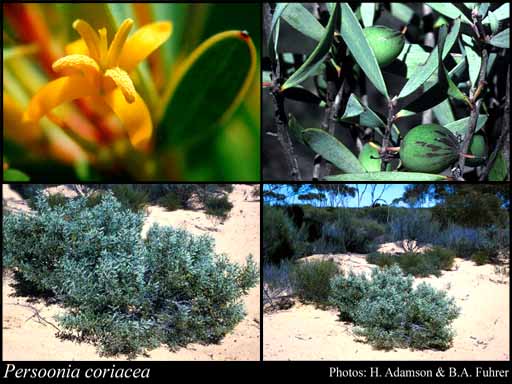- Reference
- J.Roy.Soc.Western Australia 15:81 (1930)
- Conservation Code
- Not threatened
- Naturalised Status
- Native to Western Australia
- Name Status
- Current
Erect, spreading, lignotuberous shrub, 0.3-2 m high. Fl. yellow, Nov to Dec or Jan to Feb. Yellow sand or sandy clay, sometimes over laterite, red sand, granite. Sandplains, dune crests.

Scientific Description
Shrubs, 1-2 m high; branchlets hairy, not ribbed. Leaves alternate, 20-60 mm long, 6-8 mm wide, glabrous; lamina flat, widest around the middle, entire, scabrous, the margins flat; apex obtuse. Inflorescences yellow; pedicels 4-7 mm long, hairy. Perianth 9-10 mm long, radially symmetrical, glabrous; anther appendage absent; ovary glabrous; pistil 8-10 mm long. Flowers in January, February, November or December. Occurs in the Eremaean (ER) or South-west (SW) Botanical Province(s), in the Yalgoo (YAL), Murchison (MUR), Great Victoria Desert (GVD), Coolgardie (COO), Geraldton Sandplains (GS) or Mallee (MAL) IBRA subregion(s).
Distribution
- IBRA Regions
- Avon Wheatbelt, Coolgardie, Geraldton Sandplains, Great Victoria Desert, Jarrah Forest, Mallee, Murchison, Yalgoo.
- IBRA Subregions
- Central, Eastern Goldfield, Eastern Mallee, Eastern Murchison, Katanning, Lesueur Sandplain, Merredin, Northern Jarrah Forest, Shield, Southern Cross, Tallering, Western Mallee.
- Local Government Areas (LGAs)
- Bruce Rock, Carnamah, Coolgardie, Coorow, Dalwallinu, Dumbleyung, Dundas, Esperance, Kondinin, Koorda, Kulin, Lake Grace, Menzies, Merredin, Moora, Mount Marshall, Narembeen, Perenjori, Tammin, Victoria Plains, Westonia, Wongan-Ballidu, Wyalkatchem, Yilgarn.